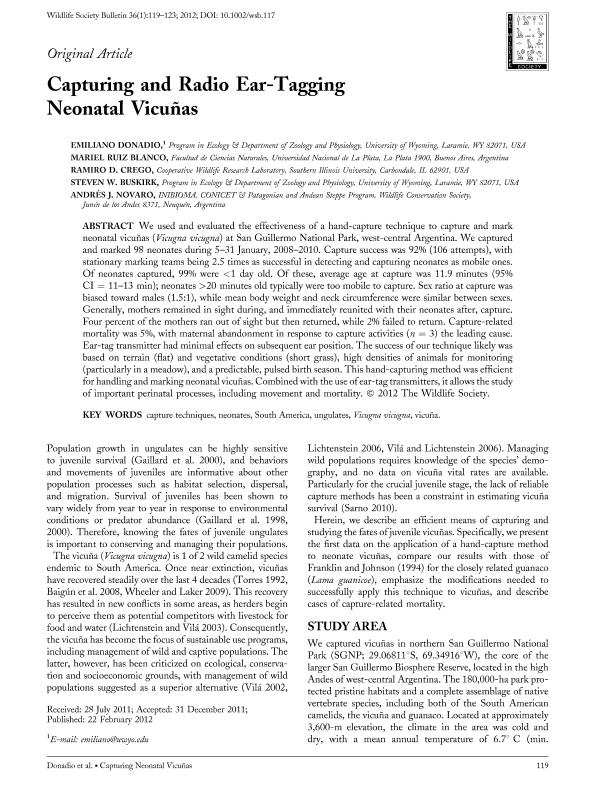Artículo
Capturing and radio ear-tagging neonatal vicuñas
Donadio, Emiliano ; Ruiz Blanco, Cynthia Mariel
; Ruiz Blanco, Cynthia Mariel ; Crego, Ramiro D.; Buskirk, Steven W.; Novaro, Andres Jose
; Crego, Ramiro D.; Buskirk, Steven W.; Novaro, Andres Jose
 ; Ruiz Blanco, Cynthia Mariel
; Ruiz Blanco, Cynthia Mariel ; Crego, Ramiro D.; Buskirk, Steven W.; Novaro, Andres Jose
; Crego, Ramiro D.; Buskirk, Steven W.; Novaro, Andres Jose
Fecha de publicación:
22/03/2012
Editorial:
Wildlife Society
Revista:
Wildlife Society Bulletin
ISSN:
0091-7648
Idioma:
Inglés
Tipo de recurso:
Artículo publicado
Clasificación temática:
Resumen
We used and evaluated the effectiveness of a hand-capture technique to capture and mark neonatal vicuñas (Vicugna vicugna) at San Guillermo National Park, west-central Argentina. We captured and marked 98 neonates during 5-31 January, 2008-2010. Capture success was 92% (106 attempts), with stationary marking teams being 2.5 times as successful in detecting and capturing neonates as mobile ones. Of neonates captured, 99% were <1 day old. Of these, average age at capture was 11.9 minutes (95% CI = 11-13 min); neonates >20 minutes old typically were too mobile to capture. Sex ratio at capture was biased toward males (1.5:1), while mean body weight and neck circumference were similar between sexes. Generally, mothers remained in sight during, and immediately reunited with their neonates after, capture. Four percent of the mothers ran out of sight but then returned, while 2% failed to return. Capture-related mortality was 5%, with maternal abandonment in response to capture activities (n = 3) the leading cause. Ear-tag transmitter had minimal effects on subsequent ear position. The success of our technique likely was based on terrain (flat) and vegetative conditions (short grass), high densities of animals for monitoring (particularly in a meadow), and a predictable, pulsed birth season. This hand-capturing method was efficient for handling and marking neonatal vicuñ as. Combined with the use of ear-tag transmitters, it allows the study of important perinatal processes, including movement and mortality.
Palabras clave:
Capture Techniques
,
Neonates
,
South America
,
Ungulates
,
Vicugna Vicugna
,
Vicuña
Archivos asociados
Licencia
Identificadores
Colecciones
Articulos(INIBIOMA)
Articulos de INST. DE INVEST.EN BIODIVERSIDAD Y MEDIOAMBIENTE
Articulos de INST. DE INVEST.EN BIODIVERSIDAD Y MEDIOAMBIENTE
Citación
Donadio, Emiliano; Ruiz Blanco, Cynthia Mariel; Crego, Ramiro D.; Buskirk, Steven W.; Novaro, Andres Jose; Capturing and radio ear-tagging neonatal vicuñas; Wildlife Society; Wildlife Society Bulletin; 36; 1; 22-3-2012; 119-123
Compartir
Altmétricas



